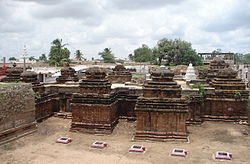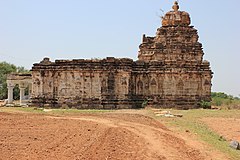Kuknur
| Kuknur / Kuknoor Kannada ಕೂಕನೂರ |
||
|---|---|---|
|
|
||
| State : |
|
|
| State : | Karnataka | |
| District : | Koppal | |
| Sub-district : | Yelbarga | |
| Location : | 15 ° 29 ′ N , 76 ° 0 ′ E | |
| Height : | 475 m | |
| Area : | 36.5 km² | |
| Residents : | 18,033 (2011) | |
| Population density : | 494 inhabitants / km² | |
| Kuknur - Navalinga Temple | ||
Kuknur (also Kuknoor or Kukanura , Kannada ಕೂಕನೂರ ) is a place with around 20,000 inhabitants in the Koppal district in the north of the Indian state of Karnataka . The place is known nationwide because of several medieval temples from the Rashtrakuta and Chalukya times.
Location and climate
Kuknur is located in the center of Karnataka on the Dekkan Plateau at an altitude of approx. 475 m, almost 35 km (driving distance) northwest of the district capital Koppal and approx. 58 km northwest of Hospet or Hampi . The temple town of Itagi is located just 7 km southwest. The climate is subtropical and warm; Rain (approx. 700 mm / year) almost only falls in the summer monsoon months .
population
Approx. 95% of the majority Kannada- speaking population are Hindus ; Muslims and other religious groups hardly play a role in most rural regions of India. The male and female proportions of the population are roughly the same. About 25% of the population are illiterate.
economy
The area around Kuknur is largely agricultural; one still lives mostly self-sufficient . However, there are also some granite quarries . Small traders, craftsmen and service providers of all kinds have also settled in the village.
history
The area around Kuknur belonged to the kingdom of the Kadamba , the Chalukyas of Badami and the Rashtrakutas in the early Middle Ages . As inscriptions attest, the city came under the sphere of influence of the Chalukyas of Kalyani in the 11th and 12th centuries until the Kalachuri and the Hoysala temporarily took power, which was followed in 1348 by the Vijayanagar Empire, which itself again in battle in 1565 von Talikota was subject to the combined armies of the Deccan sultanates . However, these were divided among themselves and so the Hindu princely state of Mysore was able to take over power for a time, which was contested by the sultans of the Adil Shahi dynasty of Bijapur . From 1761 to 1799 Haidar Ali and Tipu Sultan , two more or less independently ruling generals of the princely state of Mysore, occupied power; thereafter the British extended their influence to southern India.
Attractions
The Navalinga (= "nine linga") - Temple complex consists of nine small temples, each with a Shiva - lingam and comes from the Rashtrakuta time (900). The individual shrines are architecturally similar; they have no vestibule ( mandapa ) and slightly different tower designs ( vimanas ) , some of which have also been destroyed. There is no figurative ornament on either the outside walls or the roof structures.
In the Mahamaya temple allegedly already mentioned in the Mahabharata epic, the deities Lakshmi , Parvati and Harihara are worshiped.
The Kalleshvara temple, which stands just outside the village, is one of the early buildings of the Chalukyas of Kalyani; it is dated to the first half of the 11th century and shows only a comparatively simple one, i. H. only a little articulated ( ratha ) and figure and ornamentless exterior view. The vestibule ( mandapa ) is divided into two parts: an open portico with channeled columns was probably added in the 18th or 19th century; the actual vestibule is lit only through the door and several smaller stone lattice windows ( jalis ) . The side view clearly shows the antarala ( sukhanasi in southern India ) protruding slightly from the stepped tower structure , in which the stairs to the elevated cella ( garbhagriha ) are located. The interior is almost square and extremely unadorned; the exterior is dominated by a kind of "umbrella dome" with a kalasha vase on top.
A total of 15 inscription stones from the period from 1005 to 1186 are scattered throughout the village; its content mentions the names of the founders, the year of reign of the respective ruler and other consecration texts.
See also
more medieval Kalleshwara temples can be found in:
- Bagali
- Hirehadagali
- Ambli / Ambali
- Tumkur
- Tandaga
Web links
- Chalukya temple - Photos and information (English)


